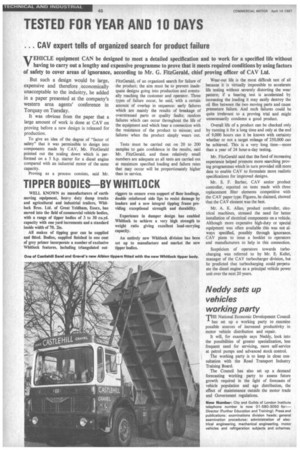TESTED FOR YEAR AND 10 DAYS
Page 50

If you've noticed an error in this article please click here to report it so we can fix it.
. . . CAV expert tells of organized search for product failure
VEHICLE equipment CAN be designed to meet a detailed specification and to work for a specified life without having to carry out a lengthy and expensive programme to prove that it meets required conditions by using factors of safety to cover areas of ignorance, according to Mr. G. FitzGerald, chief proving officer of CAV Ltd.
But such a design would be large, expensive and therefore economically unacceptable to the industry, he added in a paper presented at the company's western area agents' conference in Torquay on Tuesday.
It was obvious from the paper that a large amount of work is done at CAV on proving before a new design is released for production.
To give an idea of the degree of "factor of safety" that it was permissible to design into components made by CAV, Mr. FitzGerald pointed out the scaling down which is performed on a 5 h.p. starter for a diesel engine compared with an industrial motor of the same capacity.
Proving as a process consists, said Mr. FitzGerald, of an organized search for failure of the product; the aim must be to prevent inadequate designs going into production and eventually reaching the customer and operator. Three types of failure occur, he said, with a certain amount of overlap in sequence: early failures which are mainly the results of breakage of overstressed parts or quality faults; random failures which can occur throughout the life of the equipment and which bear a connection with the resistance of the product to misuse; and failures when the product simply wears out.
Tests must be carried out on 20 to 200 samples to gain confidence in the results, said Mr. FitzGerald, and these relatively small numbers are adequate as all tests are carried out at maximum specified loading and failure rates that may occur will be proportionately higher than in service. Wear-out life is the most difficult test of all because it is virtually impossible to accelerate life testing without severely distorting the wear pattern; if a bearing test is accelerated by increasing the loading it may easily destroy the oil film between the two moving parts and cause premature failure. And such failures could be quite irrelevant to a proving trial and might unnecessarily condemn a good product.
Overall life of a product can be checked only by running it for a long time and only at the end of 9,000 hours can it be known with certainty whether or not a target mileage of 250,000 can be achieved. This is a very long time—more than a year of 24 hour-a-day testing.
Mr. FitzGerald said that the fund of increasing experience helped promote more searching proving programmes which in turn provided still more data to enable CAV to formulate more realistic specifications for improved designs.
Mr. S. F. Barber, CAV senior product controller, reported on tests made with three replacement filter elements competitive with the CAV paper type. Figures, he claimed, showed that the CAV element was the best.
Mr. A. K. Allan, product controller, electrical machines, stressed the need for better installation of electrical components on a vehicle. Although more expensive high-duty or special equipment was often available this was not always specified, possibly through ignorance. CAV plans to issue a booklet to operators and manufacturers to help in this connection.
Scepticism of operators towards turbocharging was referred to by Mr. E. Kellet, manager of the CAV turbocharger division, but he predicted that turbocharging could perpetuate the diesel engine as a principal vehicle power unit over the next 20 years.
























































































































